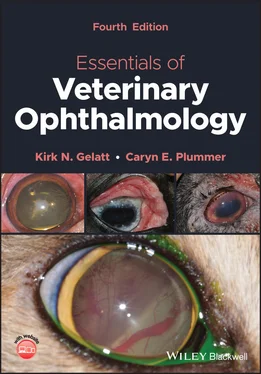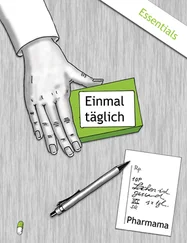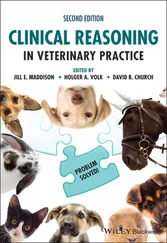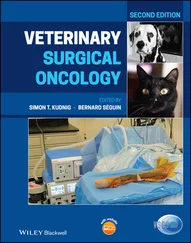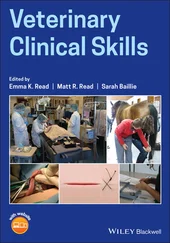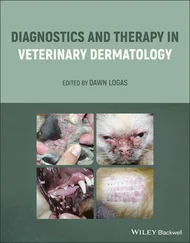Some species are monochromats. Rod monochromacy is mainly found in some fish species, whereas marine mammal species and a few terrestrial mammalian species, including the owl monkey, are cone monochromats.
Most mammals, including cats, dogs, horses, cattle, goats, sheep, and swine, are dichromats, just like human protanopes or deuteranopes .Horses, for example, have cone opsins with peak absorbance in the blue and green parts of the spectrum, making their color vision comparable to human protanopes . Dogs (and cats), on the other hand, have cone opsins most sensitive to blue and greenish‐yellow, making their color vision more similar to that of human deuteranopes ( Figure 2.19). When light stimulates the two opsins in a dichromat equally (a monochromatic light of a wavelength that coincides with the intersection of the absorption curves), the retina will not be able to distinguish this wavelength from an achromatic stimulus. This neutral point is reported at about 505 nm in the cat, and 480 nm in the dog and horse. Despite having fewer cones than humans and being dichromats, color vision cues seem to be important during daylight conditions for dogs, and it is likely that other mammalian species also take advantage of their ability to discriminate between different wavelengths to enhance their daily lives, and particularly their sexual and feeding behavior.
Some dichromats, including many rodents, such as the mouse, rat, gerbil, and Siberian hamster, have a specialized short‐wavelength opsin that peaks in the UV range of the spectrum rather than in the blue. Hence, they have extended the spectral range of the electromagnetic radiation that they can perceive. Furthermore, some dichromats that have “regular” S‐ and M/L‐cone pigments, such as the reindeer and dog (and most likely the cat, too), have lenses transmitting UV light, which enables them to see in the UV part of the spectrum using their regular cone pigments.
Many modern‐day reptilian, avian, and fish species still have all four ancestral photopigments, including an additional short‐wavelength opsin with peak absorbance in the UV or violet range (355–450 nm) that humans and most domestic mammals have lost, and have thus tetrachromatic vision .
Birds have developed additional unique mechanisms for color vision. Their double cones are used for fine spatial discrimination (visual acuity), while single cones are used for color vision. Oil droplets found in the cones of birds contribute to color perception by filtering out different wavelengths of incoming light and shifting the wavelength sensitivity of the photoreceptor.
Visual acuity is the minimal detection power of the eye, or the minimal angle that can be resolved by the eye. There are a number of ways to express visual acuity, but the best known method is based on the Snellen chart. This is determined by the size of letters that a subject can read at a distance of 20 ft, or 6 m. Obviously, determination of Snellen acuity requires verbal cooperation by the test subject and therefore is not applicable in veterinary medicine. In animals, visual acuity can be determined using behavioral discrimination tests, by electrophysiological recordings to determine the smallest pattern that elicits an ERG or cortical response, or by pursuit (i.e., optokinetic) eye responses to determine the smallest stimulus that elicits a tracking eye movement. Acuity is also often determined by theoretical calculations based on cone or RGC density ( Table 2.16).

Figure 2.19 A colorful dog, as seen by a normal trichromat (a). In (b), the color information from the photograph has been extracted. The photograph has been filtered to mimic how a protanope (c), a deuteranope (d), a tritanope (e), and a cone monochromat (f) would perceive the same scene. The protanope and deuteranope can distinguish between short and long wavelengths, whereas the tritanope can subdivide the middle‐to‐long wavelengths into different hues.
Table 2.16 Visual acuity in select species. a
| Species |
Snellen resolution b |
Spatial frequency (cycles/degree) b |
Method c |
References |
| Eagle ( Aquila audax ) |
20/4 |
140 |
Behavioral and anatomical |
Reymond (1985) |
| Falcon ( Falco berigora ) |
20/8 |
73 |
Behavioral and anatomical |
Reymond (1987) |
| Macaque monkey |
20/16 |
38 |
Behavioral |
Merigan & Katz (1990) |
| Human |
20/20 |
30 |
|
Ravikumar et al. (2011) |
| Horse |
20/26 |
23 |
Behavioral |
Timney & Keil (1992) |
|
20/36 |
16.5 |
Anatomical |
Harman et al. (1999) |
| King penguin |
|
|
Anatomical |
Coimbra et al. (2012) |
| Underwater |
20/30 |
20.4 |
|
|
| In air |
20/40 |
15.3 |
|
|
| Alpaca |
20/45 |
13.4 |
Anatomical |
Wang et al. (2015) |
| Sheep |
20/51–20/43 |
11.7–14 |
Behavioral |
Sugnaseelan et al. (2013) |
|
20/86–20/60 |
7–10 |
Anatomical |
Hughes (1977) |
| Camel |
20/60 |
10 |
Anatomical |
Harman et al. (2001) |
| Dog |
20/140–20/52 |
4.3–11.6 |
Electrophysiology |
Odom et al. (1983); Ofri et al. (1993); Murphy et al. (1997) |
|
20/110–20/31 |
5.5–19.5 |
Behavioral |
Lind et al. (2017) |
| Cat |
20/190 |
3.2 |
Behavioral |
Jarvis & Wathes (2007) |
|
20/90 |
6.5 |
Electrophysiology |
Berkley & Watkins (1971) |
|
20/33 |
18 |
Anatomical |
Steinberg et al. (1973); Clark & Clark (2013) |
| Barn owl |
|
|
Behavioral |
Orlowski et al. (2012) |
|
20/190 |
3.2 (Mesopic) |
|
|
|
20/500 |
1.2 (Scotopic) |
|
|
| Rabbit |
20/200 |
3 |
Electrophysiology |
Pak (1984) |
| Cow |
20/460–20/230 |
1.3–2.6 |
Behavioral |
Rehkämper et al. (1998, 2000) |
| Rat |
|
|
Behavioral |
Prusky et al. (2002) |
| pigmented |
20/600–20/400 |
1–1.5 |
|
|
| albino |
20/1200 |
0.5 |
|
|
| Mouse |
20/1000 |
0.58 |
Behavioral |
Lehmann et al. (2012) |
|
20/1500 |
0.39 |
Optokinetics |
Lehmann et al. (2012) |
aThis table mostly contains data for species commonly seen by veterinary ophthalmologists in clinical and research settings. Avian species have been included to demonstrate their high acuity (eagle, falcon) or the effects of aquatic vision (penguin) and light conditions (owl). The scientific literature reports visual acuity values for numerous other species such as giraffes, elephants, rhinoceros and marsupials that are beyond the scope of this book.
bMost articles report visual acuity in cycles/degree. These values have been converted to Snellen units by the author (R.O.) as most readers are more familiar with this latter scale. Values for Snellen acuity <20/200 have been rounded.
Читать дальше
